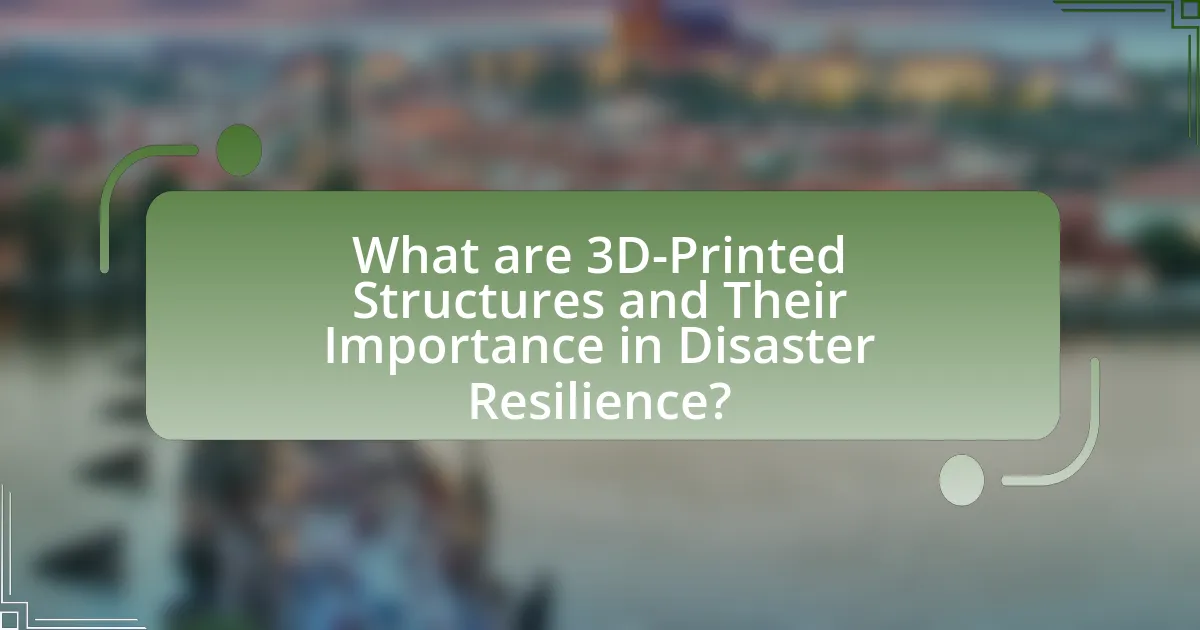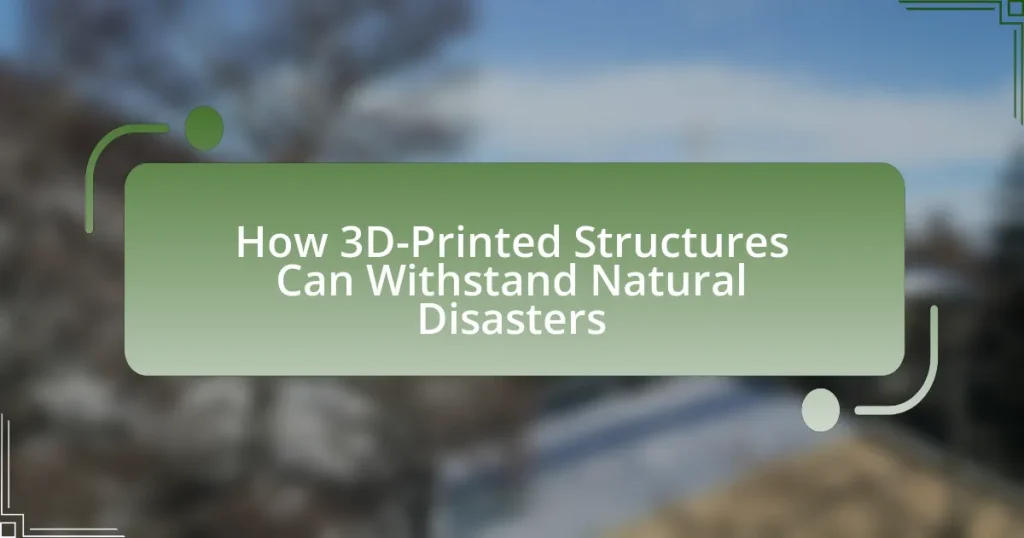3D-printed structures are innovative buildings created through additive manufacturing, offering rapid production and customization for disaster resilience. These structures utilize durable materials, such as concrete and thermoplastics, which enhance their ability to withstand extreme conditions like earthquakes, floods, and hurricanes. The article explores the differences between 3D printing and traditional construction methods, the materials used, and the design flexibility that contributes to structural resilience. It also addresses the importance of developing disaster-resistant buildings, the challenges faced in implementing 3D printing technology, and the future prospects for these structures in disaster-prone areas.

What are 3D-Printed Structures and Their Importance in Disaster Resilience?
3D-printed structures are buildings or components created using additive manufacturing technology, which layers materials to form objects. Their importance in disaster resilience lies in their ability to be rapidly produced, customized for specific needs, and constructed from durable materials that can withstand extreme conditions. For instance, research indicates that 3D-printed concrete can enhance structural integrity and reduce construction time by up to 70%, making it a viable solution for rebuilding after natural disasters. Additionally, the flexibility in design allows for the incorporation of features that improve safety and functionality in disaster-prone areas.
How do 3D-Printed Structures differ from traditional construction methods?
3D-printed structures differ from traditional construction methods primarily in their fabrication process, which utilizes additive manufacturing techniques rather than subtractive methods. Traditional construction typically involves assembling materials like wood, concrete, and steel through cutting, shaping, and joining, while 3D printing builds structures layer by layer from digital models, allowing for complex geometries and reduced material waste. For instance, a study by the University of Southern California found that 3D printing can reduce construction time by up to 70% and material usage by 30%, demonstrating its efficiency and sustainability compared to conventional methods.
What materials are commonly used in 3D printing for construction?
Common materials used in 3D printing for construction include concrete, thermoplastics, and metal alloys. Concrete is widely utilized due to its strength, durability, and ability to be mixed with additives for enhanced properties. Thermoplastics, such as PLA and ABS, are favored for their ease of use and versatility in creating complex shapes. Metal alloys, particularly aluminum and steel, are employed for their structural integrity and resistance to environmental factors. These materials have been proven effective in various construction applications, including disaster-resistant structures, as they can be engineered to withstand extreme conditions.
How does the design flexibility of 3D printing enhance structural resilience?
The design flexibility of 3D printing enhances structural resilience by allowing for the creation of complex geometries and customized structures that can better absorb and distribute stress during extreme events. This adaptability enables engineers to optimize designs for specific environmental conditions, such as earthquakes or floods, resulting in structures that are not only lighter but also stronger. For instance, research has shown that 3D-printed lattice structures can significantly improve load-bearing capacity while minimizing material use, which contributes to overall resilience. Additionally, the ability to rapidly prototype and iterate designs allows for continuous improvement based on real-world performance data, further enhancing the structural integrity of buildings in disaster-prone areas.
Why is it crucial to develop structures that can withstand natural disasters?
Developing structures that can withstand natural disasters is crucial to protect human life and property. Natural disasters, such as earthquakes, hurricanes, and floods, can cause significant destruction, leading to loss of life, economic hardship, and long-term displacement of communities. For instance, the 2010 Haiti earthquake resulted in over 200,000 fatalities and left millions homeless, highlighting the urgent need for resilient infrastructure. By creating buildings designed to endure extreme conditions, we can minimize casualties and reduce recovery costs, ultimately fostering safer and more sustainable communities.
What types of natural disasters pose the greatest threat to buildings?
Natural disasters that pose the greatest threat to buildings include earthquakes, hurricanes, floods, and wildfires. Earthquakes can cause significant structural damage due to ground shaking, with the 2010 Haiti earthquake resulting in over 200,000 deaths and widespread building collapses. Hurricanes bring high winds and storm surges, as seen with Hurricane Katrina in 2005, which devastated New Orleans and led to extensive property damage. Floods, often resulting from heavy rainfall or storm surges, can undermine foundations and lead to structural failure, exemplified by the flooding in Houston during Hurricane Harvey in 2017. Wildfires can engulf buildings in flames, as demonstrated by the 2018 Camp Fire in California, which destroyed over 18,000 structures. Each of these disasters highlights the vulnerabilities of traditional building methods and underscores the need for innovative solutions like 3D-printed structures that can better withstand such threats.
How do natural disasters impact communities and economies?
Natural disasters significantly disrupt communities and economies by causing loss of life, destruction of infrastructure, and economic downturns. For instance, the 2010 earthquake in Haiti resulted in over 200,000 deaths and devastated the nation’s infrastructure, leading to a decline in economic activity and increased poverty levels. Additionally, natural disasters can displace populations, leading to long-term social challenges and increased demand for public services. The economic impact is often quantified; for example, Hurricane Katrina in 2005 caused an estimated $125 billion in damages, severely affecting local businesses and employment rates. These events highlight the critical need for resilient structures, such as 3D-printed buildings, which can mitigate damage and support quicker recovery.
What role does technology play in enhancing the durability of 3D-Printed Structures?
Technology significantly enhances the durability of 3D-printed structures by enabling the use of advanced materials and precise manufacturing techniques. Innovations such as high-performance polymers, composites, and smart materials improve resistance to environmental stressors, while techniques like layer-by-layer construction ensure structural integrity. For instance, research indicates that incorporating carbon fiber into 3D printing can increase tensile strength by up to 200%, making structures more resilient to forces encountered during natural disasters. Additionally, technologies like simulation software allow for optimized designs that can better withstand seismic and wind loads, further validating the role of technology in enhancing durability.
How do advanced printing techniques improve structural integrity?
Advanced printing techniques enhance structural integrity by enabling precise control over material distribution and geometry. This precision allows for the creation of complex shapes and internal structures that optimize load-bearing capabilities. For instance, techniques like selective laser sintering and fused deposition modeling can produce lattice structures that reduce weight while maintaining strength, as evidenced by research from the University of Southern California, which demonstrated that 3D-printed components can achieve up to 30% greater strength-to-weight ratios compared to traditional materials. Additionally, these techniques facilitate the use of advanced materials, such as composites and bio-based polymers, which further improve durability and resistance to environmental stresses, crucial for structures designed to withstand natural disasters.
What innovations in materials science contribute to disaster-resistant designs?
Innovations in materials science that contribute to disaster-resistant designs include the development of advanced composites, self-healing materials, and 3D-printed structures using resilient materials. Advanced composites, such as carbon fiber reinforced polymers, provide high strength-to-weight ratios and enhanced durability against extreme weather conditions. Self-healing materials, which can autonomously repair damage, increase the longevity and safety of structures during disasters. Additionally, 3D printing technology allows for the creation of complex geometries and optimized designs that can better absorb and dissipate energy from impacts, as demonstrated in research by the Massachusetts Institute of Technology, which shows that 3D-printed structures can be tailored for specific environmental challenges.
How can 3D-Printed Structures be optimized for specific natural disasters?
3D-printed structures can be optimized for specific natural disasters by utilizing materials and design techniques tailored to withstand the unique forces associated with each disaster type. For example, in earthquake-prone areas, structures can be designed with flexible joints and a low center of gravity to absorb seismic shocks, as demonstrated by research from the University of Southern California, which found that certain geometries significantly enhance stability during tremors. In flood-prone regions, 3D-printed buildings can incorporate elevated foundations and water-resistant materials, as shown in studies by the National Institute of Standards and Technology, which emphasize the importance of elevation in flood resilience. For hurricane-prone areas, aerodynamic shapes and reinforced walls can be employed to reduce wind resistance and prevent structural failure, supported by findings from the American Society of Civil Engineers that highlight the effectiveness of specific design features in high-wind scenarios. By integrating these tailored approaches, 3D-printed structures can effectively mitigate the impacts of various natural disasters.
What design features are effective against earthquakes?
Effective design features against earthquakes include base isolation, energy dissipation systems, and reinforced structures. Base isolation involves placing a building on flexible bearings that absorb seismic waves, reducing the amount of energy transferred to the structure. Energy dissipation systems, such as dampers, absorb and dissipate seismic energy, minimizing structural movement. Reinforced structures, utilizing materials like steel and concrete, enhance strength and stability, allowing buildings to withstand lateral forces during an earthquake. Research has shown that buildings designed with these features can significantly reduce damage and improve safety during seismic events.
How can 3D-Printed Structures be designed to resist flooding?
3D-Printed Structures can be designed to resist flooding by incorporating elevated foundations, waterproof materials, and drainage systems. Elevated foundations prevent water from entering the structure, while waterproof materials, such as hydrophobic polymers, enhance resistance to water damage. Additionally, integrated drainage systems can redirect water away from the structure, minimizing flood impact. Research indicates that structures built with these features can significantly reduce flood-related damage, as evidenced by case studies in flood-prone areas where such designs have been successfully implemented.
What are the challenges in implementing 3D-Printed Structures for disaster resilience?
The challenges in implementing 3D-Printed Structures for disaster resilience include material limitations, regulatory hurdles, and technical expertise requirements. Material limitations arise because not all 3D printing materials possess the necessary strength and durability to withstand extreme weather conditions, as evidenced by studies indicating that traditional construction materials often outperform 3D-printed alternatives in structural integrity. Regulatory hurdles exist due to the lack of established building codes and standards specifically for 3D-printed structures, which can delay project approvals and increase costs. Additionally, the need for specialized technical expertise in both 3D printing technology and disaster resilience design poses a barrier, as the current workforce may not be adequately trained to implement these advanced construction methods effectively.
What regulatory hurdles must be overcome for widespread adoption?
Widespread adoption of 3D-printed structures for disaster resilience faces regulatory hurdles such as building codes, safety standards, and material certifications. Building codes often do not account for innovative construction methods like 3D printing, requiring updates to ensure compliance with safety and structural integrity. Additionally, safety standards must be established to evaluate the performance of 3D-printed materials under various environmental conditions. Material certifications are also necessary to validate that the materials used in 3D printing meet industry standards for durability and safety, as evidenced by the need for compliance with ASTM International standards for construction materials.
How can cost-effectiveness be achieved in 3D printing for construction?
Cost-effectiveness in 3D printing for construction can be achieved by optimizing material usage and reducing labor costs. By utilizing advanced algorithms and design software, construction projects can minimize waste through precise material application, which can reduce costs by up to 30% according to studies from the National Institute of Standards and Technology. Additionally, 3D printing technology significantly decreases the need for manual labor, as automated processes can complete tasks faster and with fewer workers, leading to labor cost savings of approximately 50%. These efficiencies not only lower overall project expenses but also enhance the speed of construction, making it a viable solution for rapid deployment in disaster-stricken areas.
What are the future prospects for 3D-Printed Structures in disaster-prone areas?
The future prospects for 3D-printed structures in disaster-prone areas are highly promising, as they offer rapid construction, cost-effectiveness, and enhanced resilience against natural disasters. Research indicates that 3D printing can significantly reduce construction time, allowing for quicker deployment of shelters in emergency situations, which is crucial in disaster recovery. For instance, a study by the Massachusetts Institute of Technology found that 3D-printed structures can be built in a fraction of the time compared to traditional methods, with some prototypes completed in less than 24 hours. Additionally, the materials used in 3D printing, such as reinforced concrete and composite materials, can be engineered to withstand extreme weather conditions, providing structural integrity during events like earthquakes and hurricanes. This adaptability and efficiency position 3D-printed structures as a viable solution for addressing housing shortages and rebuilding efforts in areas frequently affected by disasters.
How can collaboration between governments and tech companies enhance resilience?
Collaboration between governments and tech companies can enhance resilience by integrating advanced technologies into disaster preparedness and response strategies. For instance, governments can leverage the innovative capabilities of tech companies to develop 3D-printed structures that are specifically designed to withstand natural disasters, such as earthquakes and floods. Research indicates that 3D printing can reduce construction time and costs while improving structural integrity, as demonstrated by projects like ICON’s 3D-printed homes in disaster-prone areas. This partnership allows for the rapid deployment of resilient infrastructure, ultimately leading to safer communities during emergencies.
What role can community engagement play in the adoption of 3D-Printed Structures?
Community engagement plays a crucial role in the adoption of 3D-printed structures by fostering trust, collaboration, and acceptance among stakeholders. Engaging local communities in the design and decision-making processes ensures that the structures meet their specific needs and preferences, which can enhance the perceived value and utility of the technology. For instance, studies have shown that when communities are involved in the planning stages of construction projects, there is a higher likelihood of successful implementation and long-term sustainability. Additionally, community engagement can facilitate knowledge sharing and education about the benefits of 3D printing, such as cost-effectiveness and resilience against natural disasters, thereby increasing public support and investment in such initiatives.
What best practices should be followed when designing 3D-Printed Structures for disaster resilience?
When designing 3D-printed structures for disaster resilience, it is essential to prioritize structural integrity, material selection, and adaptability. Structural integrity can be ensured by utilizing design principles that account for load distribution and stress points, which are critical during extreme weather events. Material selection should focus on durable, weather-resistant materials such as reinforced concrete or advanced polymers that can withstand environmental stresses. Adaptability involves creating designs that can be easily modified or expanded based on specific disaster scenarios, allowing for rapid response and recovery. These practices are supported by research indicating that structures designed with these considerations can significantly reduce damage during disasters, as evidenced by case studies of 3D-printed buildings in earthquake-prone regions.




